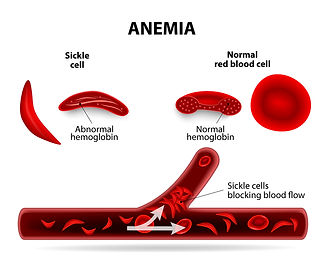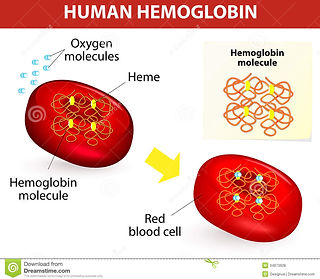Sickle Cell Anemia
Brief Overview
Sickle Cell Anemia is a multi-system disorder and is one of the most common genetic disorders in the U.S. Sickle Cell is involved by only one single gene, that codes for a specific protein. This is the HBB gene on the Beta-Globin protein chain. If you were to read about Thalaseemia you would notice that this same gene and the same portion were involved. Sickle Cell has links with many other genetic disorders, which we will future discuss. Many of them, like Sickle cell, follow an Autosomal Recessive inheritance pattern. This mutation occurs on specifically chromosome 11, whereas for Thalassemia it happens elsewhere. Before we dive any further, we should discuss the roles and possible treatments available for this disease. Sickle cell, like thalassemia, involves Hemoglobin, which carries oxygen in the blood(Image 12). Beta globin and another similar protein combine to form hemoglobin, which is crucial for the human body as it supplies the rest of the body with enough blood(Kondamudi & Sedrak, 2021).
Deeper Explanation

Image 12: Explaining the simple definition of hemoglobin, differentiating normal hemoglobin and sickle-shaped versions
Sickle Cell Anemia is an inherited disorder of the globin chains that result in hemolysis and chronic organ damage. This Disorder was first founded by Dr.Africanus Horton and written in his book "The Disease of Tropical Climates and their Treatment, but the first "real discovery" of it, was by Dr.Herrick and Dr.Irons when they noticed in a dental student. Dr.Linus Pauling also ran into this same discovery as he researched more about Thalassemia as describes the molecular nature of these sickle-shaped blood cells. Sickle Cell scientists to uncover, because of its various subunits. They include sickle cell anemia, hemoglobin SC disease, and hemoglobin sickle-beta thalassemia. As we analyze this, it is also important to understand the fact that the Sickle-Cell Trait carries a Heterozygous mutation and displays itself with many signs and symptoms. Sickle-Cell Anemia has been seeing immense amounts of research, and new methods such as gene therapy are being used to combat it (Kondamudi & Sedrak, 2021).
This disease revolves around the Hemoglobin protein, which is a major protein in the Red Blood Cells. (Image 13) It helps the blood carry oxygen to all the organs. Hemoglobin is made up of four globin chains, two of which are alpha-globin on chromosome 16, and two of which being beta-globin on chromosome 11. Hemoglobin's most common and most effective type is the one mentioned above, but other fewer effects types include HBA2, which has 2 alpha and 2 delta globins, and HBF, which has 2 alpha and 2 gamma globins. The sickle cell mutation occurs when negatively charged glutamine is replaced by te valine, which is neutral at the 6th position of the beta-globin chain. This disease follows an autosomal codominant inheritance pattern and based on whether you are homozygous or heterozygous for his gene affects the severity. The homozygous mutation leads to the most severe form, whereas Heterozygous mutation means that you have another good copy of the gene and is not as severe(Kondamudi & Sedrak, 2021).
A common similarity observed by scientists is between Thalassemia and Sickle Cell Anemia, which is due to environmental reasons. In West Africa, malaria originated from when Europeans had come and destroyed towns to conduct their slave trade and during that process, the disease spread to Sub - Saharan Africa. When it did, it affected and killed many people, but a small mutation in malaria allowed humans to have this sickle cell disorder, which in turn protected against malaria. Sickle Cell Disease targets children, as 50 to 90% of the children with this disease die before they are age 5(Kondamudi & Sedrak, 2021).
Sickle Cell Anemia is categorized by Hemolysis and vaso-occlusive crisis. The defect in the beta-globin gene makes hemoglobin susceptible to convert into long, rigid polymers. In patients with Sickle Cell Anemia, peripheral blood smear is a common feature to look at, as it shows these elongated Red Blood Cells. An important feature to consider is the fact that all humans will get Vaso-occlusive crisis if they are affected with Sickle Cell Anemia. This causes acute and chronic issues. Acute and chronic issues are two different features that are caused by Vaso-occlusive crises (Image 14), and each one has its own symptoms. For acute issues, complications include Acute Chest Syndrome, Sequestrian Crisis, Acute stroke, Aplastic Crises, Acute intrahepatic cholestasis, Infections, and Priapism. Acute Ocular complications include Hyphema, Central Retinal Artery Occlusion, Orbital infection, Orbital Compression syndrome. Chronic Complications include Iron Overload, Avascular Necrosis of Joints, Leg Ulcers, Pulmonary Artery Hypertension, Renal complications, and Opthalamologic Complications. These are the possible issues that could occur with Sickle Cell Anemia, and if you would like to observe them in more detail, please navigate to the resource under the resources tab. As it has many different issues, this genetic disorder also has possible treatments. They are pain management, which could be using medications, Management of Chronic Pain, and Blood transfusions. These are for managing the disorder and making sure that you will stay healthy(Kondamudi & Sedrak, 2021).
Now, we move into the topic of gene therapy. The goal of using this is to reduce the frequency of vaso-occlusive crisis, pain crisis and to prevent organ damage. Possible Disease-modifying drugs include Hydroxyurea, which is a ribonucleic reductase inhibitor that increases the concentration of HBF in patients. Though HBF provides very little hemoglobin, increasing it substantially can help maintain a human body. Everyone cannot be applicable to this, which is why if you have more than 3 severe pain crisis attacks within the span of 12 months or less, you should lean to this. Other possible drugs include Voxeletor, Crizanlizumab, L - Glutamine, and Hematopoietic stem cell transplant. A lot of research has gone into this disease as it has major life-threatening issues (Image 15)(Kondamudi & Sedrak, 2021).
Sickle Cell Anemia is a systemic disorder that affects the entire body, but it also plays psycho-social parts of your brain. The majority of citizens with this disease are African Americans, as it originated from them and which caused the immunity to Malaria. There are high demands for opioids to limit the pain of this disease, and all specialties need to be involved with this disease which can prove to be costly. As new drugs come out, specialists and even nurses have to be able to give a safe dosage and medication delivery to patients to make sure that this disorder will shrink, and not affect so many people(Kondamudi & Sedrak, 2021).



Image 13: This image displays what Hemoglobin is, and what it does, and what is inside it.
Image 14: This image describes the process of vaso-occlusive crises and briefly mentions how it affects certain stages like bone marrow, hemoglobin and how It could cause issues like acute chess syndrome.
Image 15: This describes the process of Gene Therapy, where a healthy gene is inserted into a Virus with its genetic code removed, and this type of virus moves through the body and can help trigger the body to make all genes you like
